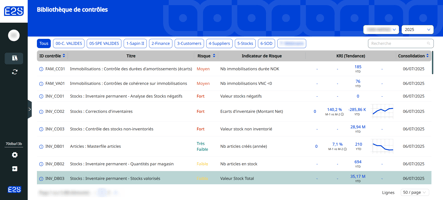Eye2Scan & Infolegale: Transforming Occupational Fraud Detection Through Dual-Layer Monitoring...
How to Demonstrate ROI and KPIs During Your Audit and Internal Control Trial Period [Article 2/3]
Starting a new role as an internal audit and control manager is a critical transition, especially during the trial period when expectations are high. Whether you're joining a company with established risk management practices or building this function in a growing organization with limited maturity, these first few months often shape how your role will be perceived long-term. This article explores practical methods to quickly demonstrate your ROI and KPIs by leveraging Eye2Scan's embedded controls, particularly in environments where audit and internal control functions are sometimes viewed merely as regulatory requirements.
A recently appointed audit and internal control director at a manufacturing company shares:
"When I joined, senior leadership viewed audit and internal control purely as cost centers. Within a year, we transformed this perception by demonstrating tangible savings and measurable improvements across our key processes."
Short-Term Wins Build Long-Term Success
Succeeding in an audit and internal control position requires capitalizing on quick wins to establish sustainable transformation. As we discussed in our previous article on onboarding, early victories create the foundation for building your strategic vision and earning stakeholder trust. These quick results become the first steps toward deeper organizational change.
Essential Controls That Deliver Immediate Results
Here are key controls that quickly identify sources of value creation:
Inventory Management Control: Optimization and Loss Prevention
Systematic inventory analysis frequently reveals significant improvement opportunities. Advanced controls for inventory discrepancies and scrap tracking, such as those built into the Eye2Scan solution, quickly identify:
- Production performance gaps that generate material losses
- Potential fraud patterns in inventory management
- Inefficiencies affecting working capital requirements
These analyses consistently lead to immediate financial gains and process optimization for long-term savings.
Invoice Duplicates: Quick and Measurable Savings
nvoice Duplicates: Quick and Measurable Savings
Implementing controls on supplier payments represents one of the most tangible examples of rapid value creation. An automated detection system not only identifies and recovers double payments but also prevents their recurrence, demonstrating the effectiveness of well-designed internal control.
Sales Price Control: Revenue Protection and Fraud Prevention
Price variation analysis is a powerful tool for optimization and fraud detection. Analyzing sales price variances against standard pricing (or margins against standard costs) allows you to quickly identify abnormal patterns that warrant attention. For example, a price significantly below average for a specific customer might indicate a data entry error, an unauthorized discount, or potentially an attempt at occasional or systematic fraud.
Segregation of Duties: Immediate Governance Strengthening
Implementing Segregation of Duties (SoD) controls quickly identifies risk situations. For instance, a single user with capabilities to both create suppliers and record invoices creates vulnerability. When combined with other Purchase-to-Pay process controls—such as monitoring manual price modifications, direct invoice recording without purchase orders, or goods receipt recording without proper separation—this approach helps detect suspicious patterns requiring deeper investigation. Beyond potential savings, these controls immediately strengthen purchasing governance and secure subsequent accounting operations.
Traditionally, implementing such cross-controls requires significant time for development and configuration. Solutions like Eye2Scan natively integrate these controls through table joins, reducing setup time to just minutes. This allows teams to focus directly on investigating detected anomalies rather than spending time on technical implementation.
Internal Audit and Control KPIs: Measuring to Demonstrate Progress
Demonstrating your added value extends beyond financial savings. Defining and tracking relevant indicators is essential to illustrate the strategic impact of your function. The challenge lies in translating priorities identified during your initial stakeholder interviews into concrete, actionable metrics.
An internal audit manager in manufacturing shares:
"The day we began sharing specific process efficiency indicators, operations teams started seeing us as true business partners rather than just the company 'police.'"
KPIs That Resonate With Operations
Purchase-to-Pay Cycle
- Post-approval purchase order modification rate
- Percentage of invoices without purchase orders
- Frequency of direct bank-to-P&L entries
Inventory Performance
- Inventory count discrepancies
- Obsolescence rate
- Inventory turnover ratio
Cash Management
- Payment term trends
- Percentage of invoices paid outside legal deadlines
- Supplier negotiation effectiveness
Major Regulatory Consideration: In 2023, the French General Directorate for Competition, Consumer Affairs and Fraud Control (DGCCRF) sanctioned 95 companies out of 248 audited for non-compliance with payment deadlines. Total fines reached €30 million, with penalties up to €2 million per company. (French Ministry of Economy)
The Challenge of Rapid Implementation in Internal Control
Identifying improvement opportunities isn't enough. The ability to implement these controls quickly presents a significant challenge, particularly during your first few months and in environments with diverse systems. Traditional approaches, such as developing custom BI solutions, often require several months of implementation and significantly drain data and IT resources.
Fortunately, specialized solutions like Eye2Scan now enable you to accelerate this implementation dramatically by activating key controls immediately without IT dependencies. Eye2Scan's automated internal control solutions help audit and compliance teams deliver measurable results quickly. In our next article, we'll explore in detail how you can generate tangible ROI with Eye2Scan for your internal audit function.
Conclusion: Transforming Audit and Internal Control into Performance Partners
Quickly demonstrating concrete results is just one aspect of a successful transition into an audit and internal control role, but it's a powerful approach to transform how these functions are perceived. By rapidly identifying and delivering measurable improvements, you establish the foundation for sustainable collaboration with operational teams while meeting board-level objectives.
This article is part of a three-part series dedicated to successful onboarding in audit and internal control. Read our next articles on leveraging audit automation tools and controls monitoring software to accelerate your impact and demonstrate measurable value.


